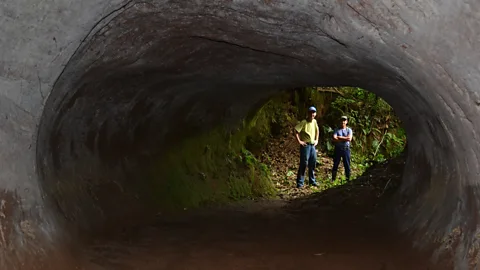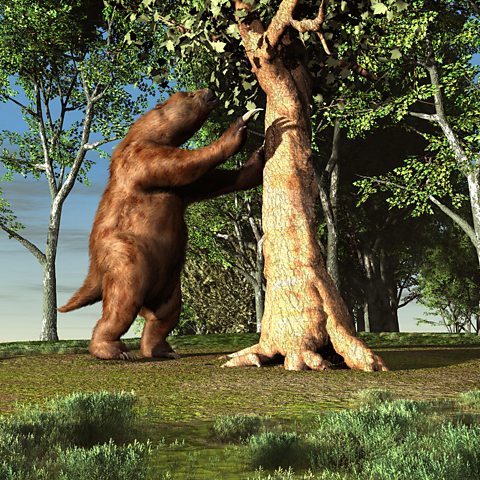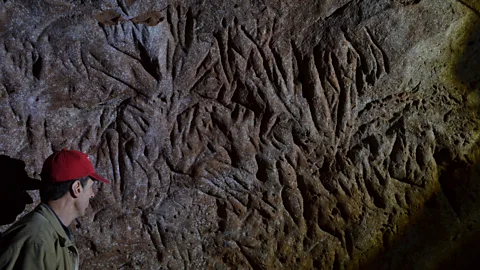Brazil’s mysterious tunnels made by giant sloths
 Heinrich Theodore Frank
Heinrich Theodore FrankThese tunnels were once believed to hide religious fortunes deep in their chambers, but the real treasure is found in who – or what – created them.
In 2009, a farmer was driving through his corn field in the south of Brazil when he suddenly felt his tractor sink and lurch to one side, making the vehicle shudder to a halt. He jumped out and saw the wheel had sunk deep into the dry soil.
Much to the farmer's shock, the tractor had broken through what looked like top of an underground cavity. Hearing about this unusual find, researchers came to investigate and were surprised to find a tunnel nearly 2m high by almost 2m wide and about 15m long running across the field and right under the farmer's house. Deep claw marks embedded into the walls indicated its past occupant was not human.
The farmer had stumbled upon a puzzling subject in palaeontology that is still unfolding today. He'd uncovered a megafauna paleoburrow, a prehistoric tunnel dug through rock by what Luiz Carlos Weinschutz, a geologist and one of the scientists who visited the farmer's property, concluded was the work of a giant ground sloth or giant armadillo from at least 10,000 years ago.
These giant ground sloths, described in one paper as "a hamster the size of an elephant", were far removed from today's unhurried, tree-dwelling ones. They grew up to 4m long and walked on all fours, although research suggests some could stand and move bipedally. Almost 100 different species of sloths roamed the Americas between 15 million to 10,000 years ago alongside car-sized giant armadillos that also dug long tunnels through rocks in Brazil.
 Esteban De Armas/Alamy
Esteban De Armas/AlamyI had first heard about paleoburrows when I saw a report in 2015 about the discovery of a 100m-long tunnel dug by giant sloths in the northern state of Rondônia, the first to be found in the Amazon rainforest. Yet it was during a holiday in the opposite end of Brazil a few years later that I had the chance to visit one in real life.
How to visit Brazilian paleoburrows
The Southern Canyons Paths Geopark has several paleoburrows that are open to the public. They are accessible via hiking and are sign-posted:
- The Engenho Velho paleoburrow complex is found in the Jacinto Machado municipality (1.5 hour return hike).
- The Toca do Tatu paleoburrow, where visitors can see rock art, is found in the Timbé do Sul municipality along the Portal do Palmiro hike. Along the same route are the Três Barras paleoburrows in the Morro Grande municipality. (4-hour return hike)
Tip: It's advisable to hire an experienced guide who can provide safety equipment such as helmets, protective clothing, masks and gloves. Contact the park directly for further information.
During this trip, I visited the Southern Canyons Path Geopark that spreads across the states of Santa Catarina and Rio Grande do Sul, home to several paleoburrows. After an hour trek through a forest-clad canyon in the state of Santa Catarina, I reached my destination: a 2m-high tunnel carved into a large, weathered rock. Inside it was dark and cool, the curved surfaces buffed smooth from many millennia of coarse sloth hair rubbing against it. Distinctive long claw marks criss-crossed the walls. It felt like walking into an oversized rabbit warren.
Heinrich Theodor Frank, a geologist by profession and paleoburrow expert at heart, told me that upon entering any one of these tunnels, "you find an open book. You see, you feel that this was not made by humans." He was right.
Most paleoburrows nowadays are filled with sediments, although some remain completely or partially clear, such as the one I had visited and the one the farmer had uncovered. The farmer's 2009 discovery came at the beginning of a surge of interest in paleoburrows, after hundreds were identified in southern and south-eastern Brazil. In the last 15 years, more than 1,500 have been recorded in this region, clinching it the title of having the highest concentration of megafauna paleoburrows in the world.
Nobody knows for sure why the south of Brazil has so many. Most are in the states of Santa Catarina and Rio Grande do Sul, but Minas Gerais, another southern state, boasts some remarkable examples, including a 340m-long paleoburrow and a collection of six 40m-long tunnels that lead to 10m-wide by 4m-high chambers. In June this year, this site – the largest paleoburrow in the state – was brought under official protection to safeguard it from human activity.
 Heinrich Theodore Frank
Heinrich Theodore FrankA handful of paleoburrows can be found across South America, although none have been recorded in North America. "It's something that has no logical explanation because the megafauna roamed across the continent. You should have tunnels in other places," said Frank.
Some experts say that the concentration of paleoburrows in Brazil's south is simply because the region is a hub for palaeontology research. Others disagree, pointing to geographical evolution influencing different behaviours among species across the Americas, which at the time of megafauna was up to 10C colder than now and much drier.
For many years, locals and researchers believed the tunnels had been constructed by past civilisations and the claw marks were assumed to be the work of a pickaxe. Some paleoburrows contain rock art, such as the Toca do Tatu ("Armadillo Burrow") in the state of Santa Catarina, which appears to have a sun with rays radiating out and groups of triangles representing mountains engraved on its walls. But because the art is carved into the rocks and not painted, dating it is almost impossible, said archaeologist Lizete Dias de Oliveira. No-one knows for sure who made the rock carvings and what they mean.
Regional Indigenous communities likely knew of the paleoburrows' existence before they were scientifically identified, evidenced by the tunnels featured in their oral stories. The Kaingang people, who come from Rio Grande do Sul, tell of a legend that a giant flood forced their ancestral fathers to swim to the hilly peaks where they eventually dug their way through the mountains for shelter. Other tales from the Kaingang suggest they knew the burrows were made by megafauna. A folktale for children involves the story of a family that descended into a hole made by an armadillo to enjoy the abundance of food there, only to have their rope cut by a "white man" (a native name for a non-Indigenous person) who took over the land while they remained underground.
 Heinrich Theodore Frank
Heinrich Theodore FrankThe exact storyline of the myths varies, but for the Kaingang people, the accuracy is less important than the story itself. "For the Kaingang people, there are no myths because everything that is told by the older Indigenous people is considered true," wrote Cláudia Aresi in a research paper for the Federal University of Rio Grande do Sul about the cultural and territory transformations of the Kaingang people.
Another theory linked to the paleoburrows was that the tunnels held hidden riches left there by the Jesuits. It led to treasure-seekers ransacking caves for this supposed wealth, never finding anything more than dust and sediments. "Treasure hunters are a horror for archaeology. They disturb the soil and reverse it, so what is newer becomes older and what is older becomes more recent," Oliveira said, adding that this complicates studying sediments for additional clues that could reveal more about these tunnels.
In the end, it was the claw marks that helped scientists conclude that these tunnels were made by megafauna, in particular ground sloths and giant armadillos. "We analysed the bones of the animals that lived in this region in the last two million years. Animals such as horses, sabretooth tigers, elephants, they did not dig. You have to look for animals that have claws, then you only have two options: the giant sloths and the giant armadillos," said Frank.
Weinschutz is currently 3D-mapping paleoburrows in Santa Catarina to try to spot patterns in the tunnels that could reveal the biomechanisms of digging such large constructions, as well as searching for traces of ancient fur to help identify the species that made them. "It's still a new study, there are years and years of research ahead in this area," he enthused.
 Heinrich Theodore Frank
Heinrich Theodore FrankThe results may shed some light onto why these animals made such large tunnels. Most scientists propose that it was for nursing young, regulating body temperatures or even hibernation, although the exact reason remains a mystery. Experts suspect that each tunnel was made over the course of centuries or even thousands of years, suggesting that the sloths and armadillos lived in social family groups. "Each generation did a little more, so after all those years, they created one big cave," Frank said.
The megafauna, both the giant armadillos and giant sloths, must have "developed an absurd strength in their arms" to be able to cut through rock and tough sediments that even a pickaxe would struggle to pierce, said Weinschutz. Intrigued, I visited the Museum of Earth Sciences in Rio de Janeiro to see the skeleton of a fossilised sloth and get a sense of its size. Its elongated skull was the size of horse and its curved claw covered my outstretched hand.
As I held the claw, my thoughts went back to the paleoburrow I'd visited with the deep scratches in the wall, the true treasures of these ancient homes. Even though the ground sloths and giant armadillos of the past have long gone, their stories remain forever marked in the south of Brazil, bringing to life a world so mysterious to us today.
---
Join more than three million BBC Travel fans by liking us on Facebook, or follow us on Twitter and Instagram.
If you liked this story, sign up for The Essential List newsletter – a handpicked selection of features, videos and can't-miss news delivered to your inbox every Friday.
